Coffee cupping – what is coffee tasting all about?
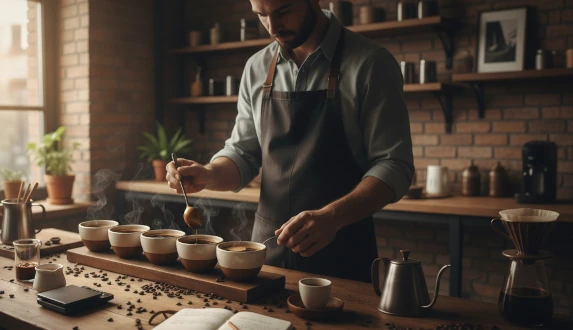
If you love coffee and want to understand it more deeply than ever before, discover the technique of coffee cupping – a ritual that allows baristas, roasters, and enthusiasts to explore every nuance of its aroma and flavour. It’s during coffee cupping that the beans “tell their story” – about their origin, processing method, and roast profile. It’s a moment when every note matters: from subtle fruity accents to rich chocolate tones.
It’s so much more than a simple coffee tasting – it’s a sensory ceremony where focus is key, and every sip becomes an experience. Coffee cupping is a method that has long been used by professionals to objectively evaluate the quality of coffee beans, but it is increasingly finding its way into the homes of coffee enthusiasts. This is how baristas around the world learn to “read” coffee flavour – recognising aroma, analysing acidity, sweetness, body and aftertaste. In this article, we will explain exactly what coffee cupping is all about, why it’s essential in the work of baristas and roasters, and how you can perform cup tasting at home to better understand the world of speciality coffee.
Summary:
- What is coffee cupping?
- Coffee tasting step by step
- Coffee flavour – how to interpret the sensations?
- Coffee cupping accessories
- Why try coffee cupping?
What is coffee cupping?
Coffee cupping (also known as cup tasting) is a professional coffee tasting method used all over the world – in roasteries as well as in barista competitions. Its main goal is to objectively assess the quality of coffee beans through the sensory evaluation of the brew: from aroma and acidity to sweetness, aftertaste and balance.
In the world of speciality coffee, coffee cupping plays a crucial role – it is not only a tool of evaluation but also a way of learning to understand flavour. Thanks to it, roasters can fine-tune roast profiles, importers can decide on purchases, and baristas learn to describe coffees professionally – the ones that eventually end up in our cups.
💡 Did you know? The word cupping comes from the word cup – “a small drinking vessel”. Literally, it means “tasting from cups”. Today, this term is used worldwide by professionals and has become the international standard for coffee evaluation.
During a coffee cupping session, multiple samples of the same or different coffees are prepared following strict guidelines. Because all the samples are brewed under identical conditions, comparing their coffee flavour becomes more reliable. There’s a reason why cupping is often called the “language of coffee” – it allows baristas anywhere in the world to describe a brew in a precise, universally understood way.
Why is coffee cupping so important?
For professionals, it’s a daily tool for maintaining quality and consistency across roasts. But coffee cupping is also becoming a popular practice among home brewers, who find it a fun and educational way to train their senses. With a handful of basic accessories and a little patience, you can begin to distinguish flavour notes that were once hidden from you.
- ☕ For roasteries: cupping helps ensure consistent roast quality and develop coffee flavour profiles.
- 👨🍳 For baristas: it’s an invaluable exercise in recognising aromas and building sensory memory.
- 🏠 For home coffee lovers: a way to consciously taste and better understand what’s in your cup.
Whether you’re a professional barista or simply a coffee enthusiast, coffee cupping invites you to see your brew from a whole new perspective. In the following sections, we’ll take you step by step through sample preparation, brewing, coffee tasting technique, and how to interpret the complex coffee flavour profile with confidence.

Coffee tasting step by step
Coffee cupping is a process that requires not only patience and focus but also consistency. Each session follows a standardised sequence – from preparing the samples to brewing and finally to the actual tasting. This repeatable structure allows tasters to compare different coffees under objective conditions and assess their quality accurately.
It’s worth remembering that coffee tasting is not just about sipping the drink – it’s about consciously discovering its rich complexity of aromas and flavours. In roasteries, coffee cupping functions as a form of quality control; among enthusiasts, it’s seen as a sensory ritual that sharpens the palate and linguistic awareness. In the next subsections, we’ll examine the standard procedure of cup tasting step by step.
Preparing coffee samples
Every coffee cupping session begins with the careful preparation of samples. Typically, three to five different coffees are cupped at once – these could be different origins, beans from the same farm roasted in different ways, or batches roasted on separate dates. The key is consistency: each sample must be prepared in exactly the same way, ensuring a fair comparison of coffee flavour.
The beans should be fresh – ideally between three and fourteen days post-roast. They are ground just before brewing, to a medium or medium-coarse texture resembling coarse sugar crystals. This grind size maintains a balance between extraction and clarity of taste. Each sample should weigh the same (e.g. 8.25 g of coffee to 150 ml of water), measured precisely on a barista scale.
Why is standardisation so important?
- ✔️ It allows coffees to be compared fairly under identical conditions.
- ✔️ It helps identify subtle flavour differences between samples.
- ✔️ It lets you create consistent sensory notes and flavour profiles.
At this stage, you also evaluate the dry aroma of the ground coffee – smell each sample separately and note your first impressions. Some coffees may reveal chocolate and nutty notes, others fruity, floral or spicy tones. This first step often gives hints of what to expect in the cup.
Pouring and brewing – the standard procedure
Once your samples are ready and weighed, it’s time to brew. Standard cupping ratios are 8.25 g of coffee per 150 ml of water or, for larger cups, 12 g per 200 ml. The water should be around 92–94°C and of good quality – ideally filtered or spring water with a neutral flavour.
When pouring the water, pour slowly and evenly to ensure all grounds are hydrated. A crust of foam and coffee particles – the crust – will form on the surface. Do not stir; instead, let the brew steep undisturbed for about 4 minutes. This time allows the coffee’s aromas and flavours to fully develop.
☕ Coffee cupping standards worldwide: Professional roasteries and organisations such as the Specialty Coffee Association (SCA) follow unified guidelines – precise weights, ratios and water temperatures. Thanks to these standards, a cup tasting session in New York, Warsaw or Tokyo will yield comparable results.
After the steeping time has passed, it’s time to “break the crust” – stir the coffee layer gently with a spoon. This is the moment when the strongest aromas burst forth, so lean in and inhale deeply before the gases escape. It’s often described as the most rewarding moment of the session – a prelude to the coffee tasting itself.
Tasting technique – how to taste coffee correctly
Coffee tasting during a cupping follows a specific set of rules. Before tasting, remove the thin layer of residue and foam left after breaking the crust – the easiest way is to use two clean spoons. Once the brew cools slightly (to around 60°C), you can begin evaluating the flavour.
And now the most important tip – slurping is essential! In coffee cupping, you don’t sip coffee as you would an espresso. The correct technique involves quickly slurping the coffee from the spoon to spread it evenly across your mouth, allowing it to reach all taste buds. This helps you fully experience the acidity, sweetness, bitterness and texture of the brew.
During coffee tasting, it’s good practice to take short notes – which coffees taste sweeter, which have more citrusy aromas, and which ones feel fuller-bodied. Professionals use the Coffee Taster’s Flavour Wheel to describe their impressions, but at home, simple categories will do: aroma, acidity, sweetness, body and aftertaste.
- ✔️ Aroma: Evaluate the fragrance – is it fruity, nutty or floral?
- ✔️ Acidity: Pleasantly lively, reminiscent of citrus fruits – or perhaps too sharp?
- ✔️ Sweetness: Do you detect notes of chocolate, caramel or honey?
- ✔️ Body: How dense is the drink – light like tea or creamy and heavy?
- ✔️ Aftertaste: What lingers after swallowing? Is the taste long-lasting, clean and well-balanced?
🥄 Cupping spoon – what is it? It’s a special, deep, rounded spoon used in professional coffee tasting. It allows you to scoop the perfect amount of brew and slurp it with the right force. This spreads the aromas evenly across the mouth, aiding sensory analysis. If you want to conduct your own coffee cupping at home, it’s worth investing in one.
In coffee cupping, it’s not about declaring one coffee “better” or “worse.” The goal is to understand differences and learn to describe coffee flavour consciously. It’s a sensory exercise that, over time, helps you detect subtle nuances between beans – whether they come from Brazil, Nicaragua or Guatemala.
In the next section, we’ll explore how to interpret flavours – how to identify specific taste notes and build a sensory profile of your coffee during cupping.
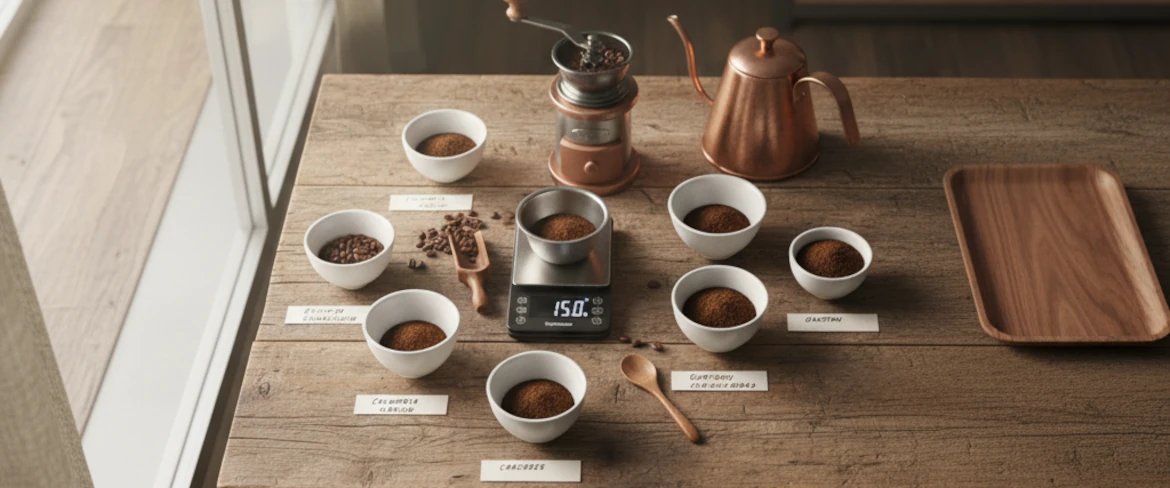
Coffee flavour – how to interpret the sensations?
In a coffee cupping session, the goal isn’t just to pick which coffee tastes better. It’s about consciously recognising and describing the sensations each brew evokes. Coffee flavour is a symphony of elements – aroma, acidity, sweetness, bitterness, body and aftertaste. Learning to identify these layers not only helps you appreciate high-quality speciality coffee but also to understand why each region produces such unique profiles.
In roasteries and barista championships, professionals rely on detailed sensory descriptions. But you don’t need to be a pro to try this yourself! All it takes is curiosity, your senses, and practice – because coffee tasting is like training your memory for flavour, improving with every cup.
Aroma, acidity, body and aftertaste
The key aspects of coffee flavour evaluation are aroma, acidity, body and aftertaste. Each element contributes something essential to the overall experience of drinking coffee. Let’s look at each one in turn.
Aroma is the first sensory clue, noticed before the coffee even touches your lips. It sets your expectations for flavour. It might be floral and delicate, fruity and lively, or deep with notes of chocolate and nuts. Professionals assess both the dry aroma of ground coffee and the wet aroma released after brewing. The moment of “breaking the crust” often exposes the most complex and characteristic scents of that particular coffee.
Acidity doesn’t mean the coffee tastes sour – quite the opposite. It’s the brightness or liveliness that gives coffee freshness and energy, similar to how citrus fruit tastes. Good acidity balances sweetness and bitterness, creating harmony. Its intensity and quality depend on the bean’s origin, processing method and roast profile.
Body refers to the weight or texture of the brew in your mouth. Some coffees feel light like tea (for example, those from Ethiopia), while others are rich and creamy, like a classic espresso from Brazil. When cupping, body is assessed by how full the mouthfeel feels and how long the flavours linger.
Aftertaste is the echo left behind once you swallow – often called the “finish”. It can be short and clean or long and evolving. In top-quality coffees, the aftertaste may reveal new notes: gentle spices, caramel, tropical fruits or a hint of minerality. It’s the final impression that makes a coffee truly memorable.
💡 Worth knowing: A perfectly balanced brew is one where no single note – whether aroma, acidity, sweetness, or aftertaste – overwhelms the others. This sense of harmony is what defines the finest speciality coffees.
How to recognise flavour notes in coffee
Recognising flavour notes in coffee becomes easier with practice. Beginners can start by comparing two coffees with contrasting profiles – say, a fruity Ethiopian and a chocolatey Colombian. Over time, your palate will learn to detect subtle nuances like floral, herbal, caramel or spice undertones.
During professional cuppings, baristas often use the Coffee Taster’s Flavour Wheel designed by the Specialty Coffee Association. This tool helps describe sensory impressions systematically – starting with broad categories like fruits or spices, and narrowing down to precise descriptors like cranberry, bergamot, cinnamon or vanilla. It turns tasting into a fascinating analytical adventure.
You can also develop your own aroma notes at home. Use a notebook (or your phone) to jot down first impressions after each sip. Over time, you’ll build a personal flavour dictionary that helps you understand your preferences and compare coffees more meaningfully.
- 🍊 Fruity notes: citrus, berries, apricots, red apples – typical of many African coffees.
- 🍫 Chocolate and cocoa: common in South and Central American varieties.
- 🌸 Floral: delicate, aromatic tones found in Ethiopian or Yemeni coffees.
- 🌰 Nutty and spicy: characteristic of the sweet, rounded profiles of Brazilian coffees.
In the next section, we’ll take a closer look at the essential coffee cupping accessories – the tools that make cupping both precise and enjoyable, whether in a professional lab or your own kitchen.
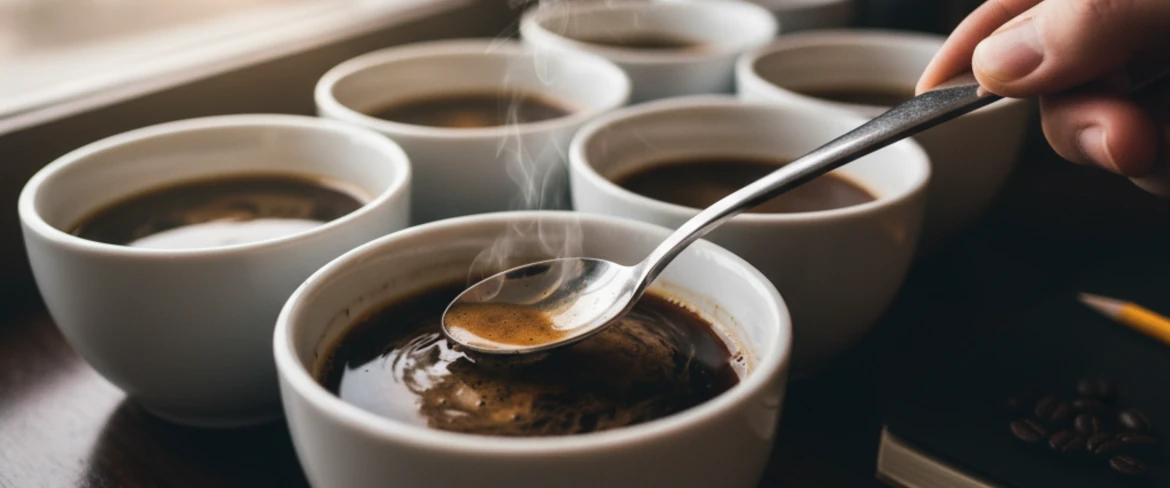
Coffee cupping accessories
Although coffee cupping may sound like a laboratory-based ritual, it doesn’t actually require specialist equipment. A few basic tools – many already found in your kitchen – are enough. The key is maintaining consistency, which allows you to compare coffees accurately and discover their unique taste and aroma.
Start with your cupping vessels – these can be bowls, small cups, or glasses of around 150–200 ml capacity, preferably heat-resistant and uniform. Each sample must be brewed in identical cups for fair comparison. You’ll also need a barista scale to measure the coffee and water precisely, ensuring equal extraction for every sample.
Next comes a good coffee grinder – ideally a burr grinder that provides a uniform grind size. In home settings, a manual grinder with adjustable grind settings works perfectly. Combined with a wooden coffee scoop, you’ll have a complete yet minimalistic setup for barista-style coffee tasting.
The essential tool, however, is the cupping spoon – deep and rounded, designed for proper “slurping” during cup tasting. It allows you to gather the perfect amount of liquid and spread it evenly across your palate, helping you fully appreciate the coffee flavour and body. You can, of course, use an ordinary soup spoon, but a cupping spoon offers better control and consistency.
Consistency and precision ensure reliable results. Make sure your water temperature and brewing time stay uniform throughout each session. This repeatable accuracy is what turns an everyday tasting into a confident coffee cupping ritual.
Here are the basic accessories you’ll need for home coffee cupping:
- ✔️ Cupping cups or bowls – for tasting and comparing coffee samples;
- ✔️ Barista scale – to measure coffee and water accurately;
- ✔️ Coffee grinder – ensures even grind size and fresh aroma;
- ✔️ Cupping spoon – enables proper slurping and flavour analysis;
- ✔️ Wooden coffee scoop – a practical and aesthetic addition to your setup;
- ✔️ Gooseneck kettle with temperature control (or a regular kettle + thermometer) – to achieve precise brewing temperature;
- ✔️ Timer or stopwatch – to track steeping and cooling time accurately.
📌 Summary: You don’t need a professional lab to organise a coffee cupping session at home. With quality beans, a consistent grinder, precise scales and identical cups, you can explore the world of coffee tasting anytime. And if you want the full barista experience, add the iconic cupping spoon – the symbol of serious coffee appreciation.

Why try coffee cupping?
Coffee cupping is much more than a method for evaluating beans – it’s a fascinating sensory experience that engages all your senses. By practising regular coffee tasting sessions, you begin to understand how profoundly factors such as origin, variety, processing method and roast profile influence coffee flavour. It’s an exercise in mindfulness and curiosity, allowing you to discover sensations in each cup that you might previously have missed – and it gradually teaches you to choose your favourite beans more consciously.
For enthusiasts, it’s an excellent form of sensory education, improving your ability to describe flavours precisely and build your coffee vocabulary. For professionals, it’s an everyday tool for quality control and refining roasting or brewing skills. But for anyone who simply loves to savour a morning cup, cup tasting can become a meaningful ritual, connecting you to the diverse and intriguing world of speciality coffee.
It’s worth trying coffee cupping not to become an expert, but to discover just how much every coffee has to offer. After only a few sessions, you’ll notice your palate becoming more perceptive, and every sip turning into a deliberate pleasure. It’s the first step towards truly knowing your perfect cup.
Prepare your cups, choose your favourite beans and discover how fascinating the world of speciality coffee can be.
FAQ – common questions about coffee cupping (cup tasting)
1. What exactly is coffee cupping?
Coffee cupping is a professional yet accessible method of coffee tasting. It involves evaluating the aroma, coffee flavour and overall quality of the brew under standardised conditions – at the same time, using the same coffee-to-water ratios. It’s how baristas and roasteries test their beans, but it’s also a way for coffee lovers to learn more about speciality coffee at home.
2. Do I need special equipment for coffee cupping?
No! For a coffee cupping session, you only need a few simple tools that you probably already have – cups or glasses, a scale, a coffee grinder, a kettle and a timer. Although a professional cupping spoon can make tasting easier, a regular soup spoon will work just fine for beginners. The most important thing is maintaining consistency and precision when preparing your samples.
3. Why do you have to “slurp” during a coffee cupping session?
The loud “slurping” sound isn’t rude – it’s a tasting technique! It helps to spray the coffee evenly over your entire palate, reaching all taste buds so you can detect different layers of coffee flavour – acidity, sweetness, bitterness and body. This method enhances your perception and makes subtle differences easier to detect.
4. What flavour notes can be found in coffee during cup tasting?
During a cup tasting session, you can discover a surprisingly wide range of notes. African coffees often feature fruity or floral tones, South American varieties display chocolate, caramel or nutty notes, while Asian coffees are known for their earthy or herbal characters. Much depends on origin, processing, and roast level.
5. Can I organise a coffee cupping session at home?
Yes, absolutely! It’s a fantastic way to train your senses and deepen your coffee knowledge. Select a few different coffees from our Coffee Broastery range, prepare them using equal measurements, and compare their aromas and flavours. Over time, you’ll learn to recognise the notes that match your preferences best.
6. What are the benefits of practising coffee cupping regularly?
Practising coffee cupping regularly builds sensory awareness. It enhances your ability to identify aromas, refine taste perception and understand coffee’s complexity. It’s also fun – a personal journey through the vast world of coffee flavour that might change the way you experience your morning brew forever.
Recommended
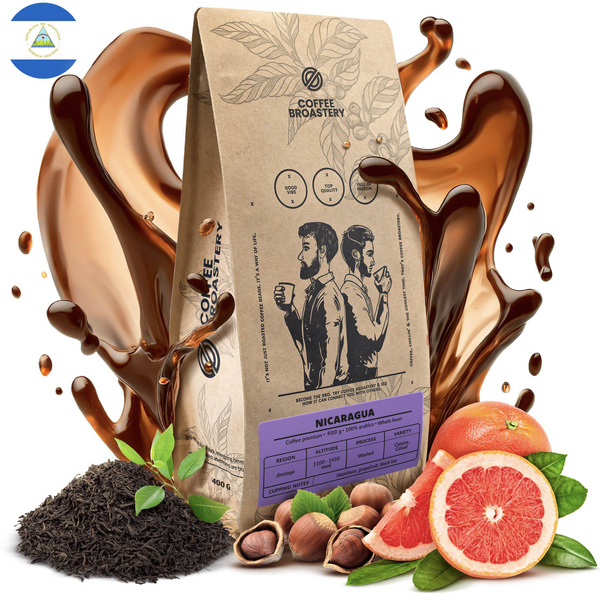
Coffee Broastery - Whole Bean Coffee Nicaragua Colibrí Azul Speciality 400g

Ceramic Cup with Lid and Infuser Mystea 300ml
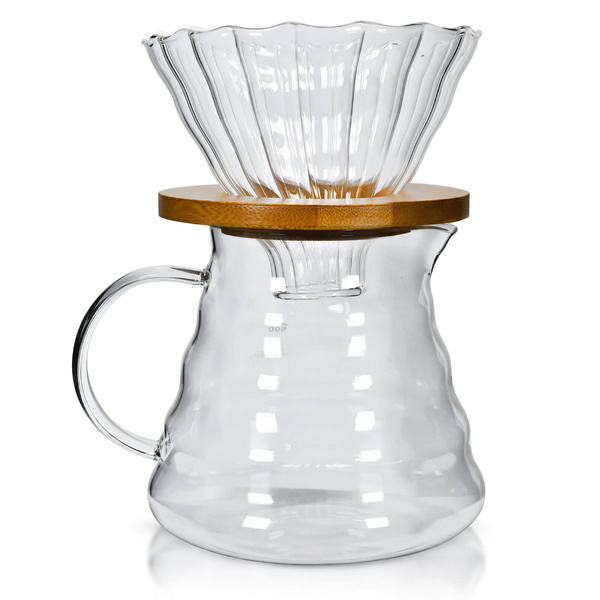
Coffee Brewing Set – Glass Dripper and Jug

